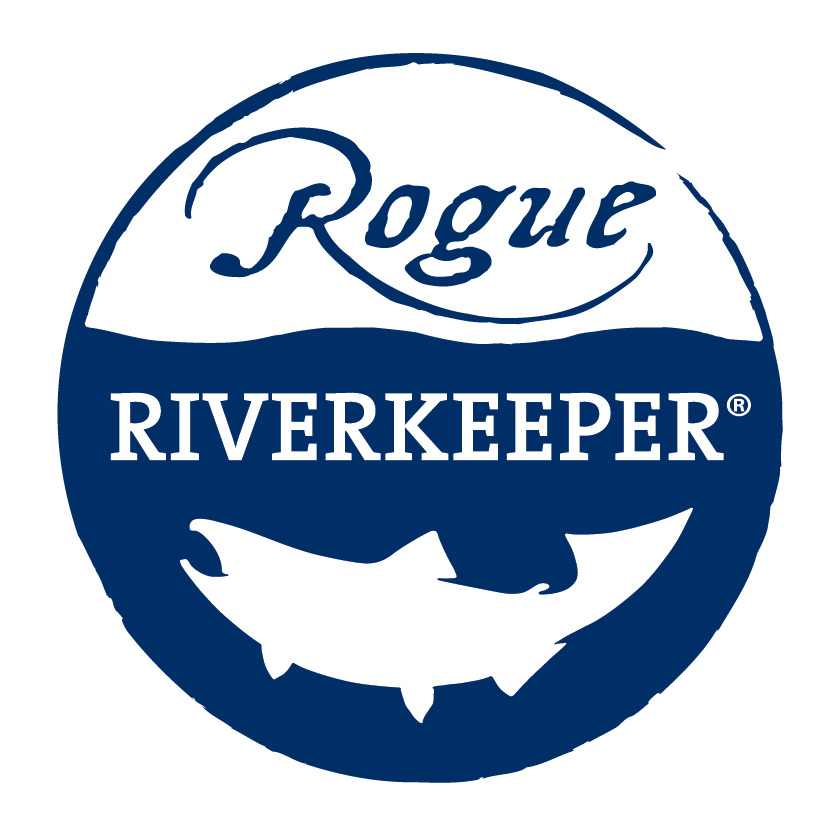Now is the Time to See Spawning Chinook Salmon in the Rogue Basin!
Hikers observe a dead salmon carcass in the Upper Rogue River. Salmon end their life cycles after returning to their spawning grounds, laying their eggs, and dying there. Their carcasses return essential nutrients to the local ecosystems. Photo credits: Frances Oyung
Fall is a great time to get outside in our region to watch salmon return inland from the Pacific Ocean up rivers to their natal watersheds. Of the six species of Pacific salmon, two occur in the Rogue basin: the Chinook salmon (also known as king), Oncorhynchus tshawytscha, and the coho salmon (also known as silver), Oncorhynchus kisutch. All of the Pacific salmon are anadromous, meaning that these fish are born in fresh water and then make their way to the ocean where they live for a period of time, reaching maturity, before returning to the freshwater streams and rivers where they were born.
There, the fish reproduce by laying their eggs in nests known as redds, and completing their lifecycle, thus rejoining the inland food web and contributing their bodies as nutrients to the surrounding water and land. The Rogue River, and its tributaries, supports some of the largest salmon populations in Oregon. In addition to salmon, other anadromous fish in the Rogue include steelhead trout, Oncorhynchus mykiss, the anadromous form of rainbow trout, and Pacific lamprey, Entosphenus tridentatus.
A salmon is spotted swimming upstream in Medford’s section of Bear Creek preparing to spawn. Photo credits: Maria Fernandez/Still Mountain Studios
Spawning Chinook salmon occur in many Rogue basin locations in October. Look for them in areas of moving water with gravel- to cobble-sized substrate. Middle Rogue tributaries like Bear Creek flowing through Ashland, Talent, Phoenix, Medford and Central Point often have Chinook spawning through the end of October into the beginning of November. As of mid-October this year, some parts of Bear Creek are very shallow due to low rainfall, making fish passage to spawning areas more difficult. Hopefully coming rains will allow easier access to the upper reaches of Bear Creek, but even with a dry fall, the lower Bear Creek area (Central Point to Medford) should have sufficient flow for Chinook spawning. In recent years, the expanded range of fall Chinook in Bear Creek all the way up to Ashland is one of the success stories for restoration in this watershed.
After Chinook start the fish spawning cycle in Bear Creek, other fish species spawn, including coho salmon, summer steelhead, cutthroat trout, winter steelhead, Klamath small-scale suckers, and Pacific lamprey spawning in the spring. As stream flows get larger and fall rains progress (hopefully!), it is harder to see these fish during spawning, but if you are in an area with suitable spawning habitat, you just might catch a view.
Chinook salmon are not as abundant as some of the other species of salmon, but can grow to a body size larger than any other Pacific salmon. Depending on the geographic population, coho are listed as either threatened or endangered under the Endangered Species Act. In the Rogue, they are listed as threatened.
Illegal dam created in the Medford section of Bear Creek. If you see suspicious activity like this, please report it to the Oregon State Police dispatch at *OSP or 541-664-4600. Photo credits: ODFW
Bear Creek and its tributaries are closed to fishing (except for the forks of Ashland Creek upstream of Reeder Reservoir), primarily to protect wild steelhead and coho. If you see poor human behavior (harassing, snagging, netting, angling) that targets fish in Bear Creek or tributaries, please report this to the Oregon State Police dispatch at *OSP or 541-664-4600. They will want to know the exact location and details, and will probably have a fish and wildlife trooper call you back. The Oregon Department of Fish & Wildlife (ODFW) fish biologists would also appreciate reports of these types of activities.
Rogue Riverkeeper works to protect and restore clean water so that native fish populations can continue to survive. We host salmon viewing walks each fall to see these miraculous fish and talk about our work to protect them. Check out our events calendar or Instagram and Facebook feeds to see where and when we are doing salmon walks. If you miss our events, get yourself out onto a local waterway and scan the riffles and gravel beds for fish. A salmon’s journey is nothing short of miraculous. I hope you can get out to catch a glimpse of these incredible fish this fall.



